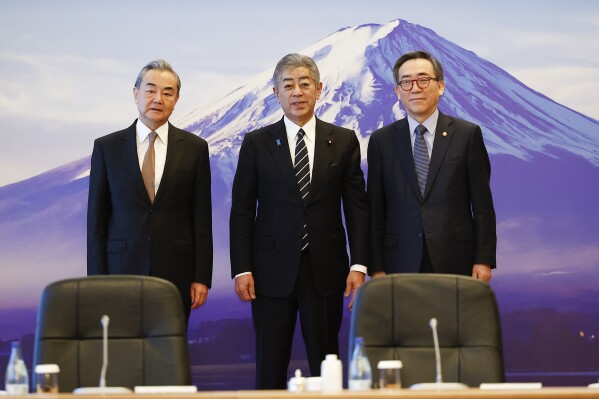
- The trilateral summit held in Tokyo in March between China, South Korea, and Japan may have been overshadowed by more headline-grabbing and conflict-driven geopolitical events around the world.
- The discussions during the meeting were aimed at cooperation on various topics of cultural exchange, climate change and disaster management coordination, the North Korean nuclear threat, and the Russia-Ukraine war.
- Ever since the Trump 2.0 administration, the unpredictable US economic policies have brought together even the most unlikely of powers.
- Regardless of the outcome, from a theoretical point of view, this trilateral meeting has several implications.
The trilateral summit held in Tokyo on March 22nd between China, South Korea, and Japan may have been overshadowed by more headline-grabbing and conflict-driven geopolitical events around the world. However, this summit is significant for regional politics and the broader economic and political landscape, especially considering China’s involvement. Thus, the meeting’s proceedings, its purpose, and its implications require closer analysis.
Why was it held?
The three ministers, Mr. Takeshi Iwaya from Japan, Mr. Wang Yi from China, and Mr. Cho Tae-Yul from South Korea, met against a backdrop of growing historical tensions to seek common ground on various issues. As neighbouring countries, China, South Korea, and Japan have experienced rising regional tensions, a natural consequence of their geographical proximity, as noted in Kautilya’s theory of international relations.
Japan and China have faced longstanding territorial disputes over the Senkaku Islands, a group of uninhabited islands in the East China Sea, which has driven a wedge between the two nations. At the same time, concerns about China’s increasing assertiveness have brought South Korea and Japan closer together, although their historical ties to the U.S. have created additional friction with China. Due to these developments, the trilateral summit, which was intended to be an annual event, was stalled for four years until the rekindling of ties at the meeting in 2024.
At this year’s meeting, the three countries aimed to strengthen their cooperation. While it is in the shared interest of all three countries to come together, in geopolitics, the larger interest is often of the smaller powers since they have more dependence on the bigger power and are more vulnerable to arm-twisting. In this case, the onus was more on Japan. Previously, Japanese companies were increasingly reluctant to do business in China due to the political uncertainty stemming from their disputes, but the lucrative size of the Chinese market has always been an everlasting interest for Japan. As explained by Norihiko Ishiguro, chairman of the Japan External Trade Organization, “large Japanese companies are still making profits from China, so Japan has no choice but to continue to do business with China.”
Thus, this meeting hints at the interdependence of economic and security concerns of the three countries. Another more important reason for the occurrence of this meeting was to pave the way for a trilateral leaders’ summit later this year, aimed at elevating their cooperation to higher levels of diplomacy.
Deliberations held
The discussions during the meeting were aimed at cooperation on various topics of cultural exchange, climate change and disaster management coordination, the North Korean nuclear threat, and the Russia- Ukraine war. The countries agreed on the urgency to address denuclearization for the stability of the entire region. “We reaffirmed that maintaining peace and stability on the Korean Peninsula is a shared interest and responsibility of the three countries,” said South Korea’s Cho Tae-yul.
Further, deliberations also revolved around the need for East Asian cooperation to build a regional economic framework. Ever since the Trump 2.0 administration, the unpredictable US economic policies have brought together even the most unlikely of powers. India-China? Similarly, China, South Korea, and Japan buried their historical hatchet for the bigger picture and discussed the way forward to reduce their dependence on American economics. To adapt to the changing economic landscape, discussions also included the planning of another trilateral summit later this year.
Expected outcomes
The uncertainty of US policies could catalyze the engagement between the three countries. Mr. Iwaya stated that “the international situation has become increasingly severe, and it is no exaggeration to say that we are at a turning point in history.” China and Japan’s bilateral economic meeting on the sidelines of the summit, after six years, further shows their efforts for dialogue to “jointly resist risks.” As Trump prepares to unleash a new set of tariff announcements at the beginning of April, the trilateral cooperation could become a more regular event to look for alternative economic pathways to reduce reliance on the US. The coming months will be a difficult balancing act for South Korea and Japan to engage with China, which will be their largest trading partner in 2025, while calculating the USA’s backing in the region.
The occurrence of bilateral meetings on the side of the trilateral meeting shows the multilevel engagement efforts of the countries, propelled by circumstances. However, there could be two likely outcomes. Either this summit could build the ground for long-term cooperation, or it could end up being a temporary coping mechanism to settle the ambers of the rising tensions. The translation into a long-term foreign policy would depend on the individual risk analysis of countries as they calculate the security, economic, and political consequences of the US stance. Their minister-level meeting later this year will paint a clearer picture of the final decision.
Theoretical implications of the Summit
Regardless of the outcome, from a theoretical point of view, this trilateral meeting has several implications. First, the summit illustrates the role of dialogue in mitigating tensions. In a world of increasing conflicts, diplomacy is still central to mediating differences. As also seen in Trump’s efforts at de-escalating the Russia-Ukraine crisis, engagement, not stalling of relations, is the answer. Second, the trilateral summit also shows the complex nature of geopolitics.
Despite friction in one aspect of the relationship, China, Japan, and South Korea were compelled to come together in their national interest to find economic solutions. The interlinkages of security, geographic, historical, and economic concerns create a cobweb of interdependent States who recognize the moment for cooperation even after years of stalled relations. Lastly, the bilateral negotiations at the summit prove the necessity for smaller powers to increase their self-sufficiency and reduce their reliance on bigger powers. This could be an example for other countries to not find themselves in the same shoes as Japan as it seeks to negotiate economic terms with an assertive China without the American safety net.
Conclusion
The trilateral summit between China, South Korea, and Japan thus holds relevance from both practical and theoretical perspectives. It shows that in a world of interdependence, the importance of dialogue cannot be undermined, especially when tensions escalate. With this in mind, perhaps their upcoming LLeaders’Summit will prove to hold even more significance and further illustrate the translation of geopolitical theory into practice.
Bishwarupa Kar is a post-graduate student at the Department of Politics and International Studies at Pondicherry University. Her areas of interest include Climate Change, Climate Action and Climate Financing, Global South, Terrorism, and Polar Studies. Views expressed are the author’s own.
